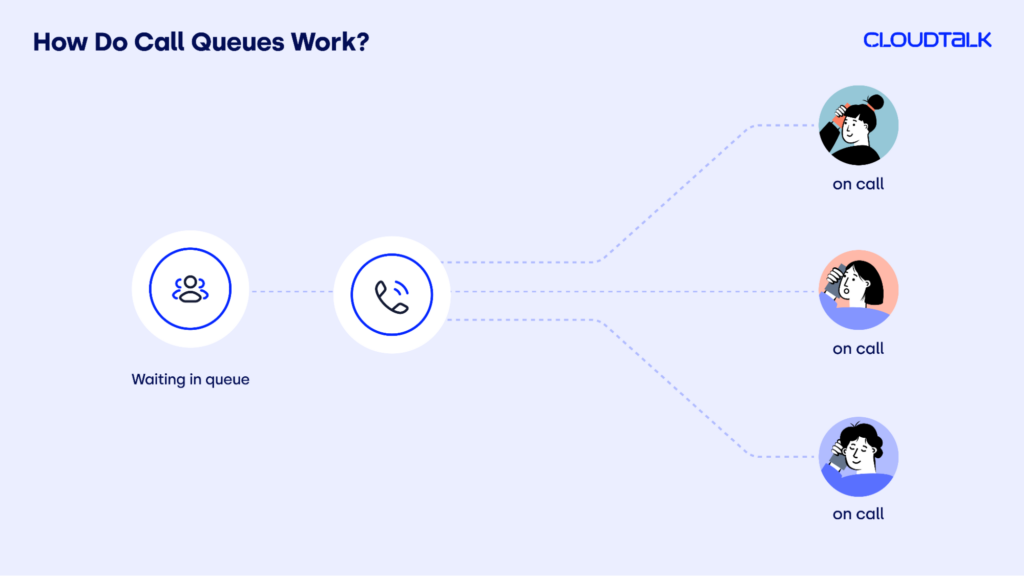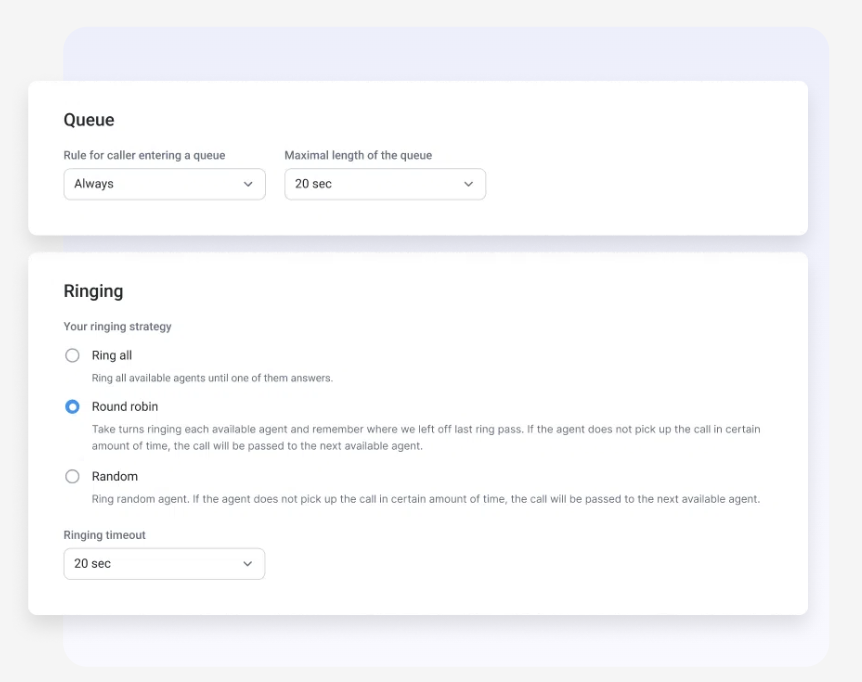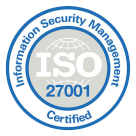What Is a Call Queue & Why Does Your Business Need One?

86% of buyers want better customer service and are willing to pay for it. So, if you can ease one of their biggest frustration, a.k.a. waiting on hold, they’ll be more than happy. Enter AI-powered call queue systems, designed to make support faster and smoother.
Without an efficient call-queuing system, businesses risk long wait times, high call abandonment rates, and frustrated customers who may take their business elsewhere. A poorly managed system can lead to overwhelmed agents, inconsistent service, and a decline in overall customer satisfaction.
In this article, we’ll discuss how you can improve your call queue system and ensure that inbound calls are handled efficiently.
See how CloudTalk can improve your call flow
What Is a Call Queue?
Ever called customer support and heard, “You’re number three in line”…? That’s a call queue in action. It’s a system that keeps incoming calls organized, placing callers in a virtual line until an agent is available.
Both big and small businesses use call centers with queues to handle high call volumes while also reducing the number of missed calls. But this system is not just about putting people on hold.
Modern call queue systems come with custom greetings, hold music, estimated wait times, and even priority routing for selected customers.
Take an e-commerce company, for example. They can use call queues to route general inquiries to a self-service menu while sending urgent refunds or shipping issues straight to a live agent. The result is shorter wait times, less frustration, and a better overall experience.
How Do Call Queues Work?
A great call queue system does more than just put people on hold. Instead, it makes their wait shorter, smoother, and less frustrating.
How does it work? A call queue organizes incoming calls, keeping things efficient when agents are busy. Instead of going to voicemail, callers are placed in a virtual line.
First, an automated greeting provides key info like business hours or menu options. Depending on the setup, callers can enter an extension, request a callback, or simply wait. The system then routes the call to the right agent, which could be the next available rep or a specialist.While waiting, callers hear hold music, queue updates, or helpful messages to make the wait less frustrating. When it’s their turn, they’re connected to an agent who already has their details, making the conversation smooth and hassle-free.

Example of Using Call Queuing
Imagine you have an online store dealing with a flood of holiday returns. Instead of overwhelming agents, your call center sorts customers by issue type; General questions go to self-service, while refund requests go straight to trained specialists.
- Routine appointment requests are directed to an online booking system or self-service menu.
- Prescription refill requests are sent to the pharmacy department without tying up front desk staff.
- Urgent medical concerns are prioritized and routed directly to a nurse or doctor.
This setup guarantees that critical calls get immediate attention. Routine requests are handled in a timely manner while upholding HIPAA regulations.
Streamline your customer support with smart call queuing
What’s Causing Your Call Queues to Be Longer Than Expected?
Call queues are supposed to make life easier for both customers and agents, but sometimes, they do the exact opposite. Long wait times leave callers frustrated, and if they feel ignored, they’ll probably just hang up and never call back.
So, what’s making your queues longer than they should be? Let’s break it down.
Not Enough Staff
One of the biggest reasons for long queues? You don’t have enough agents to handle the volume. Maybe a few people called in sick, or maybe no one planned for that big marketing campaign that’s now flooding your phone lines.
Either way, overwhelmed agents plus too many callers equals long hold times.
How to fix it:
- Look at past call data to predict peak hours and adjust staffing.
- Offer a call-back option so customers don’t have to wait on hold.
- Bring in extra help during busy seasons if needed.
Agents Who Aren’t Fully Trained
Even if you have enough staff, it slows everything down if they’re not trained properly. If an agent doesn’t know the answer, they might put the caller on hold, transfer them around, or take extra time figuring it out. All of these make the queue longer.
How to fix it:
- Invest in regular training so agents can handle calls faster.
- Give them a knowledge base so they can quickly find answers.
- Use call monitoring and coaching to improve response times.
Outdated or Clunky Technology
Your queue will always be long if your call system isn’t working efficiently. Maybe your software can’t handle a high volume of calls, or it’s not routing calls properly. And if customers keep getting transferred or put back in line, the wait gets worse.
How to fix it:
- Upgrade to AI-powered call routing that connects callers to the right agent faster.
- Use IVR menus to gather details before an agent even picks up.
- Make sure your CRM is integrated so agents have caller info upfront.
No Alternative Ways to Get Help
If calling is the only option, your queue is naturally going to be long. Some people just need a quick answer, and if they’re stuck waiting on hold for something a chatbot or FAQ page could solve, that’s wasted time for everyone.
How to fix it:
- Add self-service options like FAQs and chatbots.
- Offer live chat, email, or social media support as alternatives.
- Let customers request a call-back instead of waiting on hold.
Callers Giving Up and Calling Again
The longer customers wait, the more likely they are to hang up only to call again later. This creates a vicious cycle where repeat callers clog the queue even more.
How to fix it:
- Give estimated wait times so customers know what to expect.
- Offer a call-back option so they don’t have to wait at all.
- Use hold music or helpful messages to keep callers engaged.
The Benefits of Well-Optimized Call Queues for Your Call Center
A solid call queue system isn’t just about keeping customers on hold. It’s about making your call center faster and more efficient. Here’s how a well-managed queue can boost business and keep customers happy:
- Fewer Missed Calls = More Revenue: 62%³ of business calls go unanswered, which means lost sales. A strong call queue ensures every call gets answered.
- Happier Customers, Higher Satisfaction: Shorter wait times mean less frustration. Features like estimated wait times, call-back options, and smart routing make the experience smoother.
- Increased Agent Productivity: Long queues stress out agents and slow things down. In fact, studies show 34%² of callers hang up if kept waiting. Smart routing sends calls to the right person faster, which reduces transfers and wasted time.
- Cost Savings Without Hiring More Staff: A great queue system lets your existing team handle calls efficiently, so you don’t need additional hires. Call-back options reduce repeat calls, saving agent time.
- Better Data & Call Insights: Know when your peak hours are, track agent performance, and analyze customer trends. Use this data to optimize scheduling, training, and call handling.
- Reduced Call Abandonment Rates: Long wait? Customers hang up. Queue updates, call-backs, and self-service tools keep customers engaged and reduce drop-offs.
- Seamless Multi-Channel Support: Customers don’t always want to call. A modern queue system integrates with chat, email, and social media, giving them more options and reducing phone traffic.
Call Queue Management Best Practices
Every call queue system is different, but a well-optimized setup can make a huge difference in reducing wait times, improving customer experience, and increasing efficiency.
Here’s what an optimized call center system should look like:
Characteristics & Results
Sets Clear expectations
Callers hear their queue position and an estimated wait time, so they know what to expect.
Offers Smart Routing
An IVR (Interactive Voice Response) asks for basic details, like why they’re calling, and directs them to the right agent.
Provides Callback Options
Instead of waiting, callers can request a call back when an agent is free.
Gives Helpful Updates
Regular queue position updates keep callers in the loop about what comes next.
Keeps Agents Prepped
When an agent picks up, they already have the caller’s details, so there’s no need to repeat information.
Let’s review some best practices that will help you get the most out of your call queue management:
#1. Plan Ahead: Predict Call Volume & Schedule Smartly
Use historical call data to identify peak times and schedule staff accordingly. Also, avoid understaffing during busy hours, like holiday seasons or marketing campaigns.
#2. Train Your Agents to Solve Issues Faster
A well-trained agent handles calls faster and more efficiently, reducing hold times. For instance, you can provide training on common issues, de-escalation techniques, and product knowledge.
One way to do this is by using call recordings and monitoring tools to coach agents and improve response times.
#3. Upgrade Your Tech: Use AI & Smart Routing
Outdated systems slow things down. Invest in a cloud-based call management solution like CloudTalk. Features like IVR, AI-powered call routing, and CRM integration speed up the process.
You need to make sure that your system can prioritize calls based on urgency or customer type (VIPs, urgent inquiries, etc.).
Direct every call to the right agent for faster, more efficient support.
#4. Make Waiting More Bearable
If callers must wait, make it less frustrating with pleasant hold music and helpful messages. Provide real-time queue updates to let customers know how long they’ll be waiting.
#5. Use Analytics to Keep Improving
Track peak call times, customer wait tolerance, and agent performance. Use real-time analytics to spot bottlenecks and improve workflow. You need a tool that offers robust reporting features so you can optimize staffing and call distribution.
#6. Adjust & Optimize Your Call Queue Strategy
Make data-backed decisions using call insights and tweak your call queue strategy accordingly. Set up priority routing for VIP customers or emergency call handling.
Additionally, you can make other changes. For instance, adjust queue limits. If the queue is too long, offer a call-back instead.
Want to Improve Your Callers’ Experience?
- 28% of customers hang up after waiting for less than 5 minutes. Don’t let that be your business!
How Do I Set up a Call Queue?
Follow these five steps to create a streamlined call queue system:
- Define your call queuing rules: Set up predefined rules to route calls based on agent skills and availability.
- Set up VIP queues & priority routing: Allow high-value customers to skip the line for faster support.
- Optimize call redirection & backup options: Redirect overflow calls to backup queues, voicemail, or external numbers.
- Choose the right call routing strategy: Use skill-based routing to connect customers with the best-suited agent for their needs and ensure high-priority callers skip the line for faster service.
- Use the right tool for smart call queue management: CloudTalk offers all that you need. It leverages AI-driven routing, real-time analytics, CRM integrations, and more.
Wondering if you’ve left something out? Here’s a call queue management setup checklist where each step is framed as a question with actionable answers:
Step & Action Item
What are your key objectives for call queue management?
Identify key pain points (missed calls, long hold times, ineffective routing).
When are your peak call hours and busiest seasons?
Analyze past call data to identify trends and adjust staffing accordingly.
Which call queue software offers the best scalability and features?
Select a cloud-based solution like CloudTalk with IVR, smart routing, and real-time analytics.
How should calls be routed for efficiency?
Implement ACD (Automatic Call Distribution) to prioritize urgent calls and evenly distribute workload.
How can you enhance the caller’s hold experience?
Customize hold music, provide estimated wait times, and play helpful queue messages.
What options can you provide to reduce wait times?
Identify key pain points (missed calls, long hold times, ineffective routing).
How should agents be trained to handle queues effectively?
Train agents on quick issue resolution, active listening, and minimizing unnecessary transfers.
How can CRM and AI improve queue management?
Integrate with CRM and AI-powered call tracking for better workflow automation and insights.
What analytics should you monitor to track performance?
Monitor queue times, agent performance, abandoned calls, and customer sentiment trends.
How can you continuously optimize your call queue strategy?
Regularly update call routing rules, staffing schedules, and automation strategies based on data insights.
Check out CloudTalk’s smart call center solutions for seamless call routing and management!
How the Right Software Can Help You Manage Your Call Queue
The right call queue management software ensures that every inbound call is handled efficiently and effectively. Here’s how it helps:
- Smart call routing by automatically directing calls to the right agent, voicemail, or external device based on predefined rules.
- VIP queues that prioritize high-value customers by moving them to the front of the queue.
- Call redirection by redirecting overflow calls to backup queues, voicemail, or external numbers.
- Skill-based routing and connecting customers with the agent best equipped to handle their specific issue.
- Seamless call queuing by placing inbound calls in a virtual queue and routing them based on pre-set rules.
Discover the Future of Conversations
CloudTalk’s Call Routing Strategies
CloudTalk’s AI-driven call queue management makes sure that your customers reach the right agent faster while improving your overall call service quality.
It offers all the features you need in a reliable call queue management system. But there’s more. CloudTalk offers flexible ring strategies to optimize your call distribution:
- Round Robin: Calls ring in sequence, one agent after another.
- Ring All: Calls ring to every available agent at the same time.
- By Lowest Calls: Calls are routed to the agent with the fewest answered calls.
- Random: Calls are assigned randomly to any available agent.

Smarter Call Queuing for Better Customer Experience
Waiting on hold can be frustrating, especially when callers have no idea how long they’ll be stuck waiting. But with smart call queuing, phone support doesn’t have to be a painful experience.
Do you want your customer calls to get routed to the right agent with the right skills? And to set up faster resolution workflows? Then, you need a reliable cloud-based call queue system. Besides happier callers, this setup lets your agents focus on solving problems rather than juggling misplaced calls.
With advanced call routing, skill-based queuing, and real-time analytics, CloudTalk transforms customer support into a hassle-free process.
Source:
FAQs
What are some examples of using call queues in business?
Call queues help manage high call volumes in call centers, healthcare, e-commerce, and support teams, ensuring calls reach the right agent efficiently.
What are the common problems solved by call queues?
A call queue system reduces long wait times, call abandonment, agent overload, and missed calls, improving call center queue management and customer service.
What does “queue” mean in a call center?
In a call center queue, queued calls are placed in a virtual telephone queue and assigned to available agents based on call queue management rules.
What are some call routing options you could use with your call queues?
Call queue software offers Round Robin, VIP priority, skill-based routing, and call redirection to optimize phone queue management and agent efficiency.
What’s the difference between a call queue and a call (or ring) group?
A call queue system places calls in a queue until an agent is free, while a ring group rings multiple agents simultaneously or in a set order.
What should I play to callers waiting in a queue?
Improve the phone call queue experience with calm music, queue updates, estimated wait times, or self-service options using call queuing software.
























